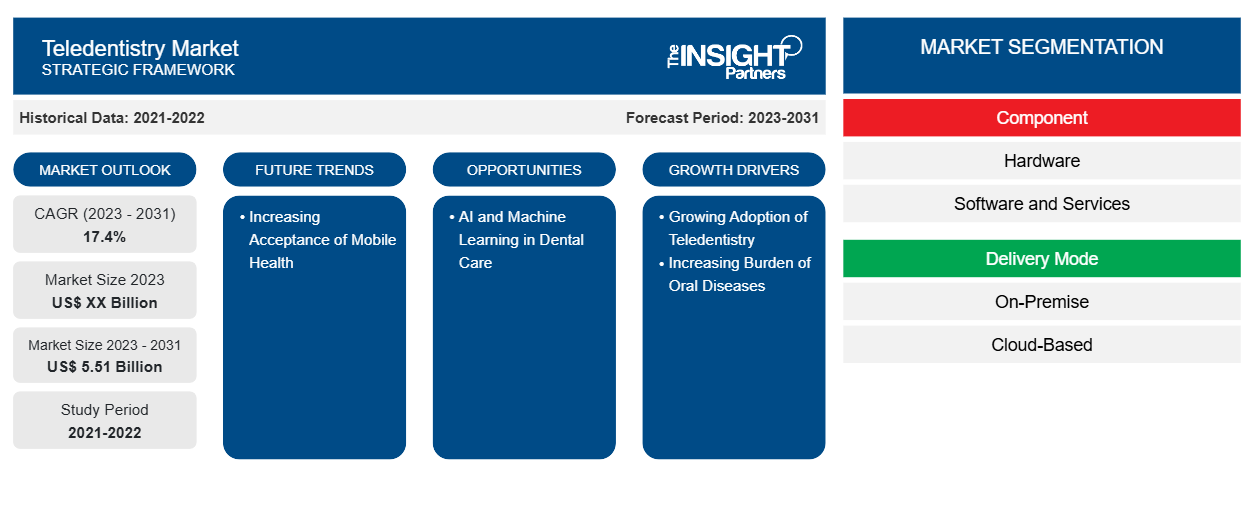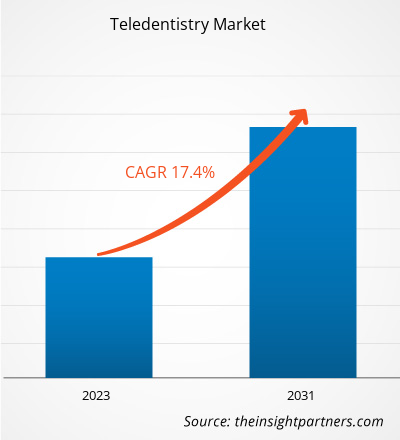The teledentistry market size in 2021 stood at US$ 1.04 billion and is projected to reach US$ 5.51 billion by 2031 from US$ XX billion in 2023. The market is expected to register a CAGR of 17.4% in 2023–2031. Increasing acceptance of mobile health is likely to remain key teledentistry market trends.
Teledentistry Market Analysis
The growth of the global teledentistry market is a direct result of the benefits it brings to the dentistry industry, such as the growing popularity of digital health solutions, advancements in communication and imaging technology, and the convenience it provides to both dental professionals and patients. Major market players are investing in strategic activities including acquisitions, mergers, collaborations, and software launches to maintain a competitive edge, resulting in market growth.
Teledentistry Market Overview
The teledentistry makes oral healthcare more accessible, especially in developing countries and during emergencies. Teledentistry, with the use of telecommunications technology, enable global access to patients and dentists by eliminating regional barriers. The growing senior population, as well as their increased acceptance of teledentistry technologies due to their convenience and cost-effectiveness, are predicted to drive industry expansion during the forecast period. The COVID-19 pandemic has had a positive significant economic impact on the teledentistry business due to the increase in the demand for virtual healthcare services.
Customize This Report To Suit Your Requirement
You will get customization on any report - free of charge - including parts of this report, or country-level analysis, Excel Data pack, as well as avail great offers and discounts for start-ups & universities
Teledentistry Market: Strategic Insights

-
Get Top Key Market Trends of this report.This FREE sample will include data analysis, ranging from market trends to estimates and forecasts.
Teledentistry Market Drivers and Opportunities
Growing Adoption of Teledentistry to Favor Market Growth
Teledentistry is a relatively new practice for the dentists and aims to provide patients with a broad range of solutions that are received from a distance. With the COVID-19 pandemic, the use of teledentistry is anticipated to witness a steady increase over the coming years in order to navigate the pandemic as well as to resume routine care. According to a report published by DentaQuest Partnership for Oral Care Advancement in November 2020, approximately 23% of dental services providers in the US have begun to see patients via teledentistry virtual platforms. Moreover, the survey also suggests that 11% of the providers that are not currently using the technology have plans to use it in the near future.
AI and Machine Learning in Dental Care
Artificial intelligence and machine learning are essential components of teledentistry. They provide personalized care plans, predictive diagnoses, and even help with treatment planning with unparalleled precision. Virtual consultations are becoming more advanced, with real-time diagnostics and interactive sessions on par with in-person consultations and visits.
Teledentistry Market Report Segmentation Analysis
Key segments that contributed to the derivation of the teledentistry market analysis are component, delivery mode, and end user.
- Based on component, the teledentistry market is bifurcated into hardware, and software & services. The software & services segment held a larger market share in 2023.
- By delivery mode, the market is bifurcated into on-premise, and cloud-based. The cloud-based segment held the larger share of the market in 2023.
- In terms of end user, the market is segmented into patients, payers, providers, and others. The providers segment dominated the market in 2023.
Teledentistry Market Share Analysis by Geography
The geographic scope of the teledentistry market report is mainly divided into five regions: North America, Asia Pacific, Europe, Middle East & Africa, and South & Central America.
North America has dominated the teledentistry market. In North America, economic prosperity, population growth and aging population, along with increased attention to oral health and improved insurance coverage (specifically in the US) are key factors driving a moderate, but steady growth in overall dental expenditures. Teledentistry is improving the health of Americans while saving money because care and education can be delivered more quickly and efficiently.
Teledentistry Market Regional Insights
The regional trends and factors influencing the Teledentistry Market throughout the forecast period have been thoroughly explained by the analysts at The Insight Partners. This section also discusses Teledentistry Market segments and geography across North America, Europe, Asia Pacific, Middle East and Africa, and South and Central America.
Teledentistry Market Report Scope
| Report Attribute | Details |
|---|---|
| Market size in 2023 | US$ XX Billion |
| Market Size by 2031 | US$ 5.51 Billion |
| Global CAGR (2023 - 2031) | 17.4% |
| Historical Data | 2021-2022 |
| Forecast period | 2023-2031 |
| Segments Covered |
By Component
|
| Regions and Countries Covered |
North America
|
| Market leaders and key company profiles |
|
Teledentistry Market Players Density: Understanding Its Impact on Business Dynamics
The Teledentistry Market is growing rapidly, driven by increasing end-user demand due to factors such as evolving consumer preferences, technological advancements, and greater awareness of the product's benefits. As demand rises, businesses are expanding their offerings, innovating to meet consumer needs, and capitalizing on emerging trends, which further fuels market growth.

- Get the Teledentistry Market top key players overview
Teledentistry Market News and Recent Developments
The teledentistry market is evaluated by gathering qualitative and quantitative data post primary and secondary research, which includes important corporate publications, association data, and databases. The following is a list of developments in the market for teledentistry:
- The TeleDentists announces our new and improved platform, powered by AmWell. Patients can now access TeleDental services through the AmWell Telehealth platform. The TeleDentists services are available 24/7/365, nationwide. (Source: The TeleDentists, Press Release, 2023)
- Virtual Dental Care (VDC), the makers of Teledentix, and Cigna have teamed up to increase access to on-demand dental care, including emergency care. Through VDC’s Teledentix secure software, Cigna customers will be able to connect to a dentist via video, text, chat, and email for instant support. (Source: Teledentix, Press Release, 2022)
- Dentulu has partnered with Pearl, the 2022 “Best of Class” AI technology winner, to enable Dentulu’s teledentists to achieve the highest level of diagnostic performance while elevating the patient experience. (Source: Dentulu, Inc., Press Release, 2023)
Teledentistry Market Report Coverage and Deliverables
The “Teledentistry Market Size and Forecast (2021–2031)” report provides a detailed analysis of the market covering below areas:
- Market size and forecast at global, regional, and country levels for all the key market segments covered under the scope
- Market dynamics such as drivers, restraints, and key opportunities
- Key future trends
- Detailed PEST/Porter’s Five Forces and SWOT analysis
- Global and regional market analysis covering key market trends, major players, regulations, and recent market developments
- Industry landscape and competition analysis covering market concentration, heat map analysis, prominent players, and recent developments
- Detailed company profiles
- Historical Analysis (2 Years), Base Year, Forecast (7 Years) with CAGR
- PEST and SWOT Analysis
- Market Size Value / Volume - Global, Regional, Country
- Industry and Competitive Landscape
- Excel Dataset
Recent Reports
Testimonials
Reason to Buy
- Informed Decision-Making
- Understanding Market Dynamics
- Competitive Analysis
- Identifying Emerging Markets
- Customer Insights
- Market Forecasts
- Risk Mitigation
- Boosting Operational Efficiency
- Strategic Planning
- Investment Justification
- Tracking Industry Innovations
- Aligning with Regulatory Trends





















 Get Free Sample For
Get Free Sample For